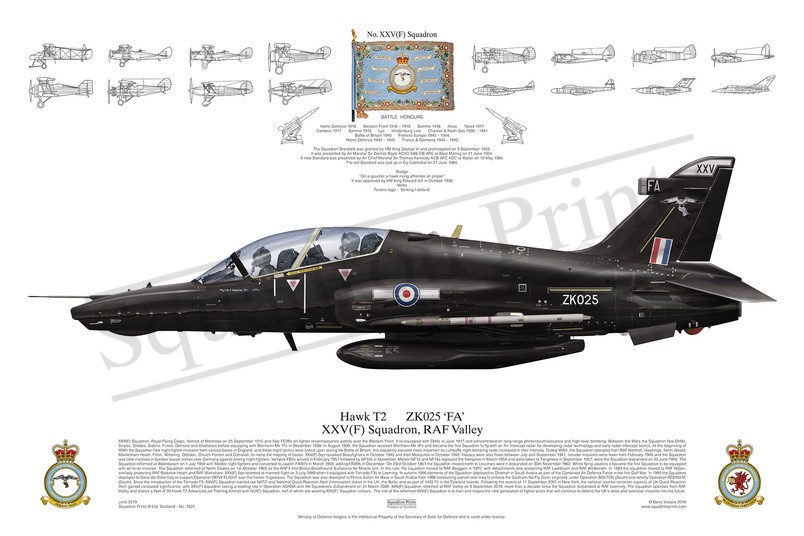#1525 Hawk T2

Purchased products will not feature the Squadron Prints watermark
Description
Squadron Prints Lithograph No. 1525 - Hawk T2, ZK025 'FA', XXV(F) Squadron, RAF Valley.
XXV(F) Squadron, Royal Flying Corps, formed at Montrose on 25 September 1915 and flew FE2Bs on fighter reconnaissance patrols over the Western Front. It re-equipped with DH4s in June 1917 and concentrated on long-range photo-reconnaissance and high-level bombing. Between the Wars the Squadron flew DH9s, Snipes, Grebes, Siskins, Furies, Demons and Gladiators before equipping with Blenheim Mk 1Fs in December 1938. In August 1939, the Squadron received Blenheim Mk 4Fs and became the first Squadron to fly with an Air Intercept radar for developing radar technology and early radar intercept tactics. At the beginning of WWII the Squadron flew night-fighter missions from various bases in England, and these night tactics were called upon during the Battle of Britain; this capability became more important as Luftwaffe night bombing raids increased in their intensity. During WWII, the Squadron operated from RAF Northolt, Hawkinge, North Weald, Martlesham Heath, Filton, Wittering, Debden, Church Fenton and Coltishall, to name the majority of bases. XXV(F) Sqn received Beaufighters in October 1940 and then Mosquitos in October 1942. Havocs were also flown between July and September 1941. Intruder missions were flown from February 1943 and the Squadron was later involved in bomber escort sorties over Germany against enemy night-fighters. Vampire FB5s arrived in February 1951 followed by NF10s in November. Meteor NF12 and NF14s replaced the Vampires in March 1954 and were taken to Tangmere in September 1957, were the Squadron disbanded on 23 June 1958. The Squadron reformed at Waterbeach on 1 July 1958 with Meteor night-fighters and converted to Javelin FAW7s in March 1959, adding FAW9s in December. On 23rd October 1961 the Squadron moved north to Leuchars were it disbanded on 30th November 1962. Whilst flying Javelins it became the first Squadron to be equipped with air-to-air missiles. The Squadron reformed at North Coates on 1st October 1963 as the RAF’s first Bristol Bloodhound Surface-to-Air Missile unit. In this role, the squadron moved to RAF Bruggen in 1970, with detachments also protecting RAF Laarbruch and RAF Wildenrath. In 1983 the squadron moved to RAF Wyton, similarly protecting RAF Barkston Heath and RAF Wattisham. XXV(F) Sqn reverted to manned flight on 3 July 1989 when it equipped with Tornado F3s at Leeming. In autumn 1990 elements of the Squadron deployed to Dharhan in Saudi Arabia as part of the Combined Air Defence Force in the first Gulf War. In 1993 the Squadron deployed to Gioia del Colle Italy to support Operation DENY FLIGHT over the former Yugoslavia. The Squadron was also deployed to Prince Sultan Air Base in Saudi Arabia from 1998 conducting patrols over Iraq to enforce the Southern No-Fly Zone, originally under Operation BOLTON (South) and latterly Operation RESINATE (South). Since the introduction of the Tornado F3, XXV(F) Squadron carried out NATO and National Quick Reaction Alert (Interceptor) duties in the UK, the Baltic and as part of 1435 Flt in the Falkland Islands. Following the events of 11 September 2001 in New York, the national counter-terrorism aspects of UK Quick Reaction Alert gained increased significance, with XXV(F) Squadron taking a leading role in Operation ADANA until the Squadron’s disbandment on 31 March 2008. XXV(F) Squadron reformed at RAF Valley on 8 September 2018, more than a decade since the Squadron disbanded at RAF Leeming. The squadron operates from RAF Valley and shares a fleet of 28 Hawk T2 Advanced Jet Training Aircraft with IV(AC) Squadron, half of which are wearing XXV(F) Squadron colours. The role of the reformed XXV(F) Squadron is to train and inspire the next generation of fighter pilots that will continue to defend the UK’s skies and overseas interests into the future.
You may also like
-
Tornado GR4, Lancaster BIII and Vulcan B2
XL392; ED932 'AJ-G'; ZA412 '017'617 SqnRAF Lossiemouth; RAF Scampton -
RAF Lossiemouth
XX745 'D'; ZA602 'F'; WR960; HE156; XV868; ZA10516 Sqn; 202 Sqn; 15 Sqn; 8 Sqn; 736 Sqn; 20 OTURAF Lossiemouth; HMS Fulmar
